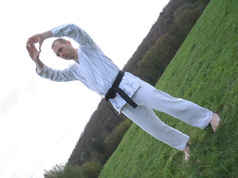The Role of the Mind

The Dalai Lama: Tenzin Gyatso
Exercise and lifestyle habits originate in the mind. Everything we do has once been a thought, and every habit we acquired was has once been single deed. The Dalai Lama said that any human habit can be changed: That does not need to be difficult, but it must occur by repeatedly thinking the right thoughts and performing the desired behaviour until it becomes a habit.
That means, if we want to become slimmer or fitter, we must first examine the thoughts we have around our lifestyles. It is one of the most profound laws of the Mind that it strives to fulfill the visions it holds, regardless whether positive or negative. If our thoughts are filled with guilt, lack of self-respect, and doubt, those thoughts will become basis for our reality. For example, if you say: 'I am trying to lose weight', you are setting yourself on a course of failure, because you will forever be 'trying' instead of 'doing'. However, if you start telling yourself while you exercise or while you opt for a healthy food choice that 'I am losing weight - right now!', your statement will set yourself on your path of optimal weight and fitness.
That means, if we want to become slimmer or fitter, we must first examine the thoughts we have around our lifestyles. It is one of the most profound laws of the Mind that it strives to fulfill the visions it holds, regardless whether positive or negative. If our thoughts are filled with guilt, lack of self-respect, and doubt, those thoughts will become basis for our reality. For example, if you say: 'I am trying to lose weight', you are setting yourself on a course of failure, because you will forever be 'trying' instead of 'doing'. However, if you start telling yourself while you exercise or while you opt for a healthy food choice that 'I am losing weight - right now!', your statement will set yourself on your path of optimal weight and fitness.
|
Visualisation is crucial. It's effectiveness has been proven for professional athletes: During the 1990s Olympic Program athletes were told to visualise their races while being hooked up to sophisticated biofeedback equipment. »Incredibly«, says Dr. Dennis Waitley »the same muscles fired, in the same sequence when they were running the race in their mind, as when they were running it on the track. How could this be? Because the mind can't distinguish whether you're really doing it, or whether it's just a practice. I think if you've been there in the mind, you'll go there in the body.«
|
Rehearsing a positive performance over and over in the mind, sets the body up to perform the same success in real life also.
Therefore, visualisation and effective psychological techniques are today widely used in the training of professional athletes. However, visualisation is not yet widely available for personal training and personal fitness, even though this is the field where it is most needed. For example: Those who think they would look silly at the gym, because others would be more fit, better looking and athletic, will not be likely to even go there. Those who start thinking at the first sign of our muscles tiring: “This is too hard for me”, will never get fit either. A restructuring and reframing of internal believes is crucial is such cases.
We know that our everyday, conscious mind is connected with a deeper subconscious. Through mental exercises we access the pictures our subconscious mind holds. We do not try to merely “erase” pictures of what we do not want, but fill our minds instead with new, powerful pictures of what we do want. This way we don’t create feelings of loss, but feelings of gain and expansion, of growing happiness and self-empowerment. There are mental exercises to train our mind, and they are therefore not just beneficial for fitness, but for every other area of our lives as well. These are the reasons why at Zenith we combine personal training with leading edge visualisation techniques.
It is only a positive mental image of ourselves and our abilities which can create a healthy mind and a healthy, beautiful body for us.
© Viktória Gy Duda
Therefore, visualisation and effective psychological techniques are today widely used in the training of professional athletes. However, visualisation is not yet widely available for personal training and personal fitness, even though this is the field where it is most needed. For example: Those who think they would look silly at the gym, because others would be more fit, better looking and athletic, will not be likely to even go there. Those who start thinking at the first sign of our muscles tiring: “This is too hard for me”, will never get fit either. A restructuring and reframing of internal believes is crucial is such cases.
We know that our everyday, conscious mind is connected with a deeper subconscious. Through mental exercises we access the pictures our subconscious mind holds. We do not try to merely “erase” pictures of what we do not want, but fill our minds instead with new, powerful pictures of what we do want. This way we don’t create feelings of loss, but feelings of gain and expansion, of growing happiness and self-empowerment. There are mental exercises to train our mind, and they are therefore not just beneficial for fitness, but for every other area of our lives as well. These are the reasons why at Zenith we combine personal training with leading edge visualisation techniques.
It is only a positive mental image of ourselves and our abilities which can create a healthy mind and a healthy, beautiful body for us.
© Viktória Gy Duda
